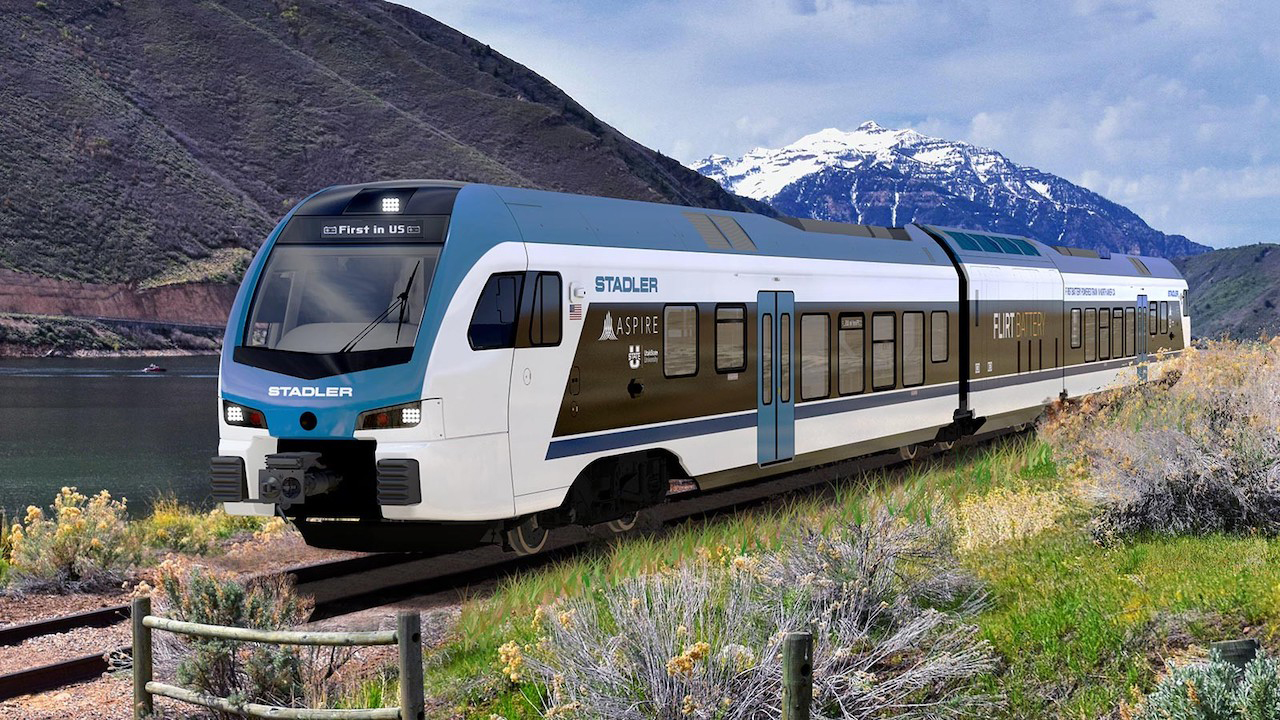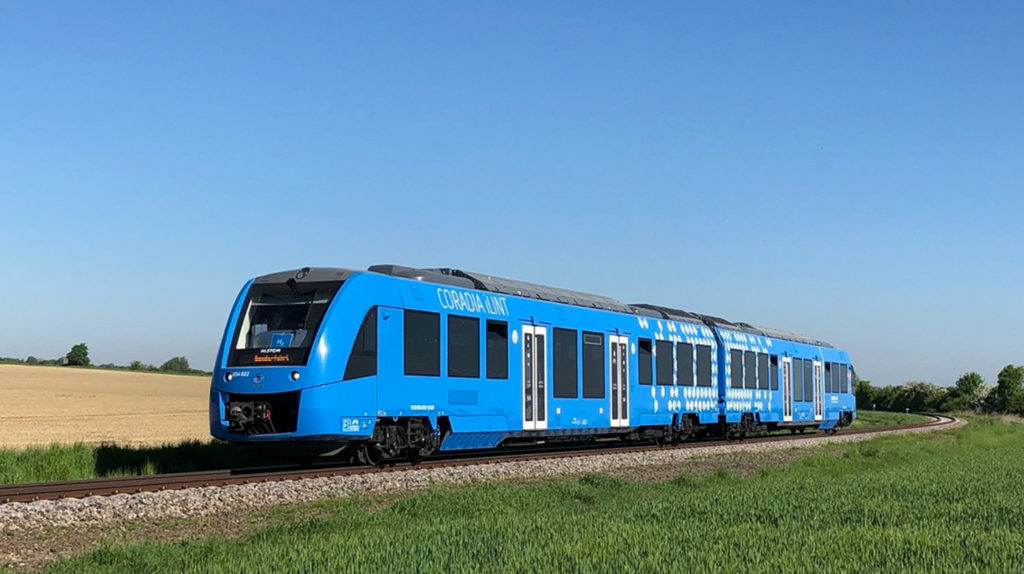
ZE Passenger Locomotive Power, by the Numbers
Written by Alex Luvishis, Ph.D
In cooperation with the ASPIRE Research Center, Stadler is developing a FLIRT Akku model tailored to the U.S. market.
U.S. regional/commuter trains traveling relatively short distances are making progress on ZE (zero emission) initiatives. The technology under evaluation comes from numerous global sources. For ZE long-distance trains, battery-electric and HFC (hydrogen fuel cell) hybrid locomotives are possible, but the requirements for generating enough power are daunting.
REGIONAL/COMMUTER
The state of California is planning to make all its passenger rail 100% emissions-free by 2035. A prototype HFC (hydrogen fuel cell) trainset, the Stadler FLIRT H2, has been tested and will begin service on San Bernardino County Transportation Authority (SBCTA) in 2024. The two-car trainset has a range of 286 miles (460 km), a top speed of 79 mph (127 kph), 116 seats and a hydrogen refueling time of less than 30 minutes. Up to 29 four-car trainsets based on this FLIRT H2 train, but with a range of 800 km, will be operated on the 139.7-mile (223.5 km) line between Merced and Sacramento from 2027.
The FLIRT Akku, a two-car battery-electric trainset based on the FLIRT H2 that meets U.S. standards, is being created by Stadler and the U.S. company ASPIRE Engineering Research Center, in cooperation with Utah State University. A three-car version operated in Germany has the following parameters: range, 150 km (93 miles); maximum speed,160 kph (100 mph); battery charge time, 15-20 minutes; 154 seats. This trainset achieved a record run in Germany of 224 km (139 miles) without recharging. On routes of 400-500 km (248-310 miles), both the FLIRT H2 and FLIRT Akku can replace DMU diesel multiple-unit) equipment in use today.
The name of Stadler’s KISS 25kV, 50Hz bilevel EMU (electric multiple-unit) train corresponds to the German KomfortablerInnovativer Spurtstarker S-Bahn-Zug, which translates into English as “Comfortable Innovative Speedy Suburban Train.” The carbody is aluminum, the bogies have a pneumatic suspension. The train is seven-car and equipped with 8 AC traction motors. Power is 6,000kw, maximum speed is 110 mph (177 kph), starting tractive force is 540 kN, starting acceleration is 1 m/s2. This equipment is expected to be in operation on Caltrain’s newly electrified, 51-mile (82-km) San Francisco-San Jose section in 2024. However, except for legacy electrified railways in the Northeast and Chicago and the new Caltrain service, virtually all main line passenger trains in the U.S. operate with diesel-electric locomotive power, typically hauling bilevel cars. The FLIRT and KISS train variants described above are not suitable for U.S. longer-distance services, mainly because they are not compliant with FRA crashworthiness standards required for mixed-use (passenger and freight) lines.
Caltrain will exercise a contract option with Stadler to purchase a battery-equipped electric multiple unit (BEMU) trainset based on the KISS, comprising three passenger cars and one battery-head housing the battery and power equipment. The California Transportation Commission on Aug. 17 approved the allocation of funds from an $80 million California State Transportation Agency grant for one BEMU, testing at the Transportation Technology Center in Pueblo, Colo.; and upgrades to the San Jose Central Maintenance Facility and Gilroy layover and station area to facilitate charging and maintenance. The current demonstration plan will have the BEMU’s batteries charge while in operation between San Francisco and San Jose in the electrified territory, and then use battery power to run on the non-electrified route between San Jose and Gilroy, with intermittent demonstration trips to Salinas. The goal, Caltrain said, is to “show successful service operations and learn from the implementation to provide a roadmap for future BEMU operations and procurements,” and ultimately “lead the way for Caltrain to operate a fully ZE service in the future.”

For locomotives, there have been some recent developments. Last year, Chicago’s Metra signed a contract with Progress Rail to convert up to six older F40PH-2 diesel-electric locomotives to battery-electric for short-distance, regional/commuter rail service. I’ve done some calculations that suggest the task of upgrading an F40PH-2 for short hauls is simpler than the task of upgrading it for long-distance trains. F40PH-2 specifications: power, 3,000 hp (2,239 kW); weight, 165 tons; top speed, 79 mph (126.4 kph). Consequently, the power and speed of the locomotive is less than that of the ALC42, but Metra required the creation of a battery-electric locomotive with a maximum range of only 93 miles (150 km). The F40PH-2 handles, in push or pull configuration, 11 double-deck gallery style cars.
LONG-DISTANCE
Today, powerful battery-electric locomotives are manufactured in the U.S. and China, but only switching and freight prototypes have been manufactured in the U.S. ZE passenger locomotives are not yet produced by the U.S. locomotive industry. What would be the requirements for a ZE long-distance locomotive? I believe such locomotives should be equivalent to the newest diesel-electric locomotive to date for powering long-distance trains, the Siemens four-axle ALC42 (Amtrak Long-Distance Charger) with AC drive, the parameters of which are: power, 4,200 hp (3,132 kW); weight, 127 tons; maximum speed, 125 mph (200 kph); starting tractive effort, 165,192 foot-pounds (290 kN). Power and maximum speeds of current battery-electric units are less than those of the ALC42.

Among the 15 Amtrak long distance-trains that have the longest routes, three routes are more than 2,000 miles, six are 1,000-2,000 miles, and six are less than 1,000 miles. Train consists differ, especially after the coronavirus pandemic. For comparison, I’ve chosen Amtrak’s Chicago-San Francisco California Zephyr.
My conversion calculations are based on a battery-electric locomotive requiring power of 2,156 kWh. Using iron-phosphate lithium-ion batteries, which Power Rail normally uses on its battery locomotives, the battery weight is 21.5 tons, and only 80% of its discharge is allowed to increase battery life. Removing the diesel engine, traction alternator and fuel tank from an F40PH-2 reduced locomotive weight by 29 tons. Thus, battery weight is a significant 7.5 tons less than the removed equipment’s weight.
Let’s carry out similar calculations for the locomotives hauling the California Zephyr, consisting of eight Superliner bilevel cars and two ALC42 locomotives, using battery-electric locomotives on the entire 2,433-mile (3,924 km) Chicago to San Francisco run. An approximate total battery power requirement calculation shows that for such a run, it should be 78,480 kWh. This approximate calculation is carried out for the average value of energy consumption by a passenger train moving on level track. Let’s define the parameters of battery-electric locomotives equivalent to converting an ALC42. The weight of the equipment removed from one locomotive is 37 tons. An iron-phosphate lithium-ion battery with a specific energy of 100 W h/kg (watt-hour per kilogram, a unit of specific energy commonly used to measure energy density in batteries and capacitors) with a weight of 37 tons yields battery power of 3,700 kWh per locomotive, enough for the train to operate 115 miles (185 km). For two electric locomotives, the mileage will be 230 miles (370 km).
Thus, for 2,433 miles (3,924 km), the two battery-electric locomotives will need to be charged 10 times on the route. If a GM Ultium NCMA (nickel-cobalt-manganese-aluminum) battery is used instead of an iron phosphate battery, three additional charges will be required. If batteries are placed in two tenders with energy of 7.1 kWh each to supplement the locomotives batteries, three additional recharges are not needed—but at the same time, it is necessary to recharge the locomotive and tender batteries.
The energy value of the 7.1 kWh battery tender is selected based on the value of that for a locomotive developed for Australian Railways 4000 series diesel-electric. (See EMD® Joule Build Under Way Down Under, Railway Age, June 1, 2023.)
In the case of using two battery-electric locomotives and two battery tenders for trains with a route length of less than 670 miles (1,080 km), no additional recharge is needed. For trains with a route length of 670 miles (1,080 km) to 1,340 miles (2,160 km), one additional recharge is required. For trains with a route length of 1,340 miles (2,160 km) to 2,009 miles (3,240 km), at least two additional recharges.
HYDROGEN FUEL CELLS
Another possible way to develop locomotives for powering double-deck trains is with HFC (hydrogen fuel cell) hybrid locomotives. For example, Alstom’s Coradia iLint HFC regional trainset as operated on DB (German Rail) has a 729-mile (1,175-km) range without stopping to refill its hydrogen tank. Currently, there are no main line HFC locomotives operating in regular main line passenger service on the world’s railways today.

Let’s determine the parameters of an HFC hybrid locomotive based on the ALC42. Due to the required power of 4,200 hp (3,132 kW), I have selected 12 Ballard fuel cell modules with a capacity of 200 kWh each. The locomotive must be a hybrid, with onboard modular battery elements of 600 kWh. I believe that for operation of 12 fuel cell modules, 4,400 pounds (2,000 kg) of hydrogen is required. Fuel cell energy output in this case is equal to 39,996 kWh; for two locomotives, 79,992 kWh—that is, enough to operate the California Zephyr between Chicago and San Francisco. The combined weight of fuel cells, batteries and hydrogen is 19 tons. During an ALC42’s conversion, the diesel engine, traction alternator and fuel tank are removed. The total weight of such equipment is 37 tons, which equates to an 18-ton weight savings.
For trains with a route length of 620 miles (1,000 km), 2,200 pounds (1,000 kg) of hydrogen are required. For trains with a route length of 1,240 miles (2,000 km), 4,400 pounds (2,000 kg) are needed.
CONCLUSIONS
Based on the above preliminary calculations, for a route length of more than 670 miles (1,080 km), HFC hybrid locomotives have advantages, since their use does not require refueling and does not require a tender. When using battery locomotives, repeated charges and the use of two battery tenders needed. Note that these are approximate calculations and only for technical comparison. For all these applications, it will be necessary to conduct a thorough technical and economic comparison of locomotive options and choose the best one.
As shown above, there are prospects for using HFC hybrid and battery-electric locomotives for hauling bilevel cars on long-distance routes. But these options must be put in perspective. Today, it is possible to start work on improving the environmental friendliness of existing locomotives. Cummins recently successfully completed tests on use of 100% HVO (hydrotreated vegetable oil) as a fuel for the QSK95 diesel engine. HVO, also known as renewable diesel or green diesel, is created from lipids like vegetable oil, tallow or used cooking oil. These lipids are made of paraffinic hydrocarbons and result in a low-carbon fuel.
Given that Germany successfully completed a thorough study of the possibility of using HVO as a fuel for the country’s diesel rolling stock, and in the near future many German diesel-electric locomotives will operate using HVO, it would be logical for U.S. passenger railways operating any variation of the Siemens Charger—all of which are equipped with the U.S. EPA Tier 4-compliant Cummins QSK95—including the ALC42, to use HVO fuel, improving the environmental friendliness of passenger rail—short-, medium- or long-distance.

Alex Luvishis, Ph.D. for 18 years headed the laboratory that developed control systems for Russia’s first electric locomotives and asynchronous traction motors in the former USSR. For a further seven years, he headed the rolling stock department at the Institute of Technical Information of Railway Transport in Moscow. Dr. Luvishis is the author of more than 100 articles on electric traction drives and the book “Hybrid Rail Vehicles,” published in 2009. His interests are asynchronous traction drive systems for modern rolling stock, and hybrid drive systems for trams, suburban and regional trains and switching and main line locomotives. He has lived in the U.S. since 1999.



